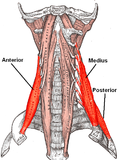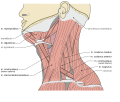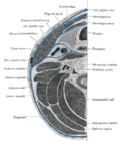Scalene muscles
Scalene Muscles
The Scalene Muscles are a group of three pairs of muscles in the lateral neck, namely the anterior scalene, middle scalene, and posterior scalene. They are innervated by the fourth, fifth, and sixth cervical spinal nerves (C4-C6).
Anatomy[edit]
The scalene muscles originate from the transverse processes of the cervical vertebrae of C2 to C7 and insert onto the first and second ribs. Thus they form part of the floor of the posterior triangle of the neck.
Anterior Scalene[edit]
The anterior scalene (from Greek skalenos, meaning uneven) is named for its unequal size compared to the other two scalenes. It originates from the transverse processes of the lower six cervical vertebrae and is inserted into the scalene tubercle on the inner border of the first rib.
Middle Scalene[edit]
The middle scalene is larger than the anterior but smaller than the posterior. It arises from the transverse processes of the lower six cervical vertebrae and is inserted into the upper surface of the first rib.
Posterior Scalene[edit]
The posterior scalene is the largest and deepest of the three muscles. It originates from the transverse processes of the lower six cervical vertebrae and is inserted into the outer surface of the second rib.
Function[edit]
The scalene muscles elevate the first and second ribs, aiding in respiration. They also function to bend the neck to the same side and rotate it to the opposite side.
Clinical Significance[edit]
Scalene muscles can be involved in several clinical conditions, including scalene syndrome and thoracic outlet syndrome.
See Also[edit]
References[edit]
<references />
| Muscles of the neck | ||||||||||
|---|---|---|---|---|---|---|---|---|---|---|
|
| Anatomy of the lower respiratory tract | ||||||||||||
|---|---|---|---|---|---|---|---|---|---|---|---|---|
|
Ad. Transform your life with W8MD's Budget GLP-1 injections from $75


W8MD offers a medical weight loss program to lose weight in Philadelphia. Our physician-supervised medical weight loss provides:
- Weight loss injections in NYC (generic and brand names):
- Zepbound / Mounjaro, Wegovy / Ozempic, Saxenda
- Most insurances accepted or discounted self-pay rates. We will obtain insurance prior authorizations if needed.
- Generic GLP1 weight loss injections from $75 for the starting dose.
- Also offer prescription weight loss medications including Phentermine, Qsymia, Diethylpropion, Contrave etc.
NYC weight loss doctor appointmentsNYC weight loss doctor appointments
Start your NYC weight loss journey today at our NYC medical weight loss and Philadelphia medical weight loss clinics.
- Call 718-946-5500 to lose weight in NYC or for medical weight loss in Philadelphia 215-676-2334.
- Tags:NYC medical weight loss, Philadelphia lose weight Zepbound NYC, Budget GLP1 weight loss injections, Wegovy Philadelphia, Wegovy NYC, Philadelphia medical weight loss, Brookly weight loss and Wegovy NYC
|
WikiMD's Wellness Encyclopedia |
| Let Food Be Thy Medicine Medicine Thy Food - Hippocrates |
Medical Disclaimer: WikiMD is not a substitute for professional medical advice. The information on WikiMD is provided as an information resource only, may be incorrect, outdated or misleading, and is not to be used or relied on for any diagnostic or treatment purposes. Please consult your health care provider before making any healthcare decisions or for guidance about a specific medical condition. WikiMD expressly disclaims responsibility, and shall have no liability, for any damages, loss, injury, or liability whatsoever suffered as a result of your reliance on the information contained in this site. By visiting this site you agree to the foregoing terms and conditions, which may from time to time be changed or supplemented by WikiMD. If you do not agree to the foregoing terms and conditions, you should not enter or use this site. See full disclaimer.
Credits:Most images are courtesy of Wikimedia commons, and templates, categories Wikipedia, licensed under CC BY SA or similar.
Translate this page: - East Asian
中文,
日本,
한국어,
South Asian
हिन्दी,
தமிழ்,
తెలుగు,
Urdu,
ಕನ್ನಡ,
Southeast Asian
Indonesian,
Vietnamese,
Thai,
မြန်မာဘာသာ,
বাংলা
European
español,
Deutsch,
français,
Greek,
português do Brasil,
polski,
română,
русский,
Nederlands,
norsk,
svenska,
suomi,
Italian
Middle Eastern & African
عربى,
Turkish,
Persian,
Hebrew,
Afrikaans,
isiZulu,
Kiswahili,
Other
Bulgarian,
Hungarian,
Czech,
Swedish,
മലയാളം,
मराठी,
ਪੰਜਾਬੀ,
ગુજરાતી,
Portuguese,
Ukrainian










